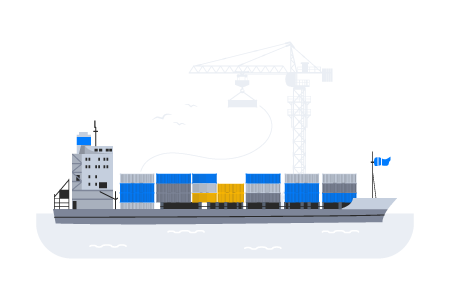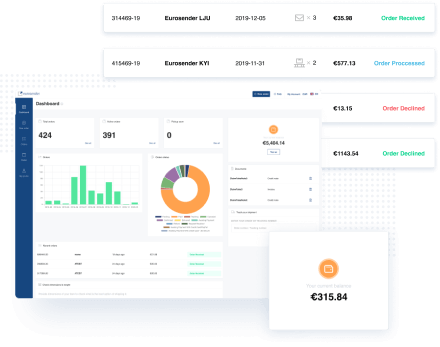International Sea Freight Services
Sea freight forwarding, also known as ocean freight, is a very cost-effective solution for transporting large quantities of goods that are not time sensitive. Among the many types of sea shipping services available, sea containers are probably the most common ones, which can be filled by one or several shippers. Whether you require pallet transport, FCL or LCL shipping, at Eurosender, we can organise effective transport of your goods by sea freight and other efficient shipping services.

REASONS TO USE
Why choose to use sea freight services?

Inexpensive service for shipping cargo through long distances

Suitable for transporting hazardous and dangerous goods

Most carbon-efficient solution compared to air and road transports
International sea freight shipments for businesses
ARE YOU A BUSINESS?
Organise the import of goods in bulk with a specialised sea freight forwarder without binding contracts or minimum volume of orders. Get already negotiated prices and support from an expert team every step of the way.

Advantages and disadvantages of sea transport


- Possibility of carrying a wide variety of cargo, with high availability of routes and vessels
- Sea freight rates are low for transporting large quantities at once, over long distances
- Most carbon-efficient mode of transport when comparing the fuel consumption to the weight transported per shipment
- Shipping by sea or ocean is the safest form of worldwide transport
- Possibility of safely transporting dangerous and hazardous goods that are forbidden in other shipping services
- Lower maintenance costs compared to rail or road transport
- Sea freight transport is slow, only suitable for shipments that are not time-sensitive
- Not cost-effective for short-distance shipments
- Vulnerable to weather conditions such as excessive rain or dry season where the water level in rivers are too low
- Further inland transportation needed to connect the port to the final destination
- Tracking of goods transported by ocean freight might be tricky
- The biggest danger of the sea freight industry is piracy
How are the sea freight quotes calculated?
- Dimensions: Size and weight of the goods to be transported by sea
- Distance: Sea freight rates are lower for long-distance shipments
- Pick-up and delivery : Further inland transportation is needed for connecting the port to the delivery address
- Type of item: The nature of the goods may influence the sea freight quote
- Insurance : Extra coverage can be purchased for additional protection of the cargo
- Customs clearance : Fees may apply for international ocean freight shipments
- Incoterms: The sea freight rate may also be influenced by the incoterms

Alternatives to shipping freight by sea
Do you have other shipping requirements?
Frequently asked questions about freight shipped by sea or ocean transport
What is sea freight forwarding?
How much does sea freight cost?
Why is sea freight so cheap?
What is the difference between sea freight & air freight?
How long does a sea freight shipment take?
What products are shipped by sea freight?
Is it possible to transport dangerous goods by sea freight?
What is the maximum weight allowed in sea freight transport?
- Deep-sea freight services: Intercontinental shipping by crossing oceans, covering long distances using big vessels. Deep-sea shipping is most often used for commodities, for example, iron ore, oil, cement, etc.
- Short sea shipping (also known as coastal shipping): Opposite to deep-sea freight services, this is a kind of shipping on relatively short distances. These vessels used in short sea shipping are much smaller and sometimes can also travel inland. They do not cross the ocean but travel along seashores and other waterways.
- Inland shipping: Shipping by vessels using inland waterways (rivers, canals, and lakes), with smaller volumes compared to both short and deep-sea shipping. Examples of products being shipped using inland waterways are petroleum, mining, and chemical products.



